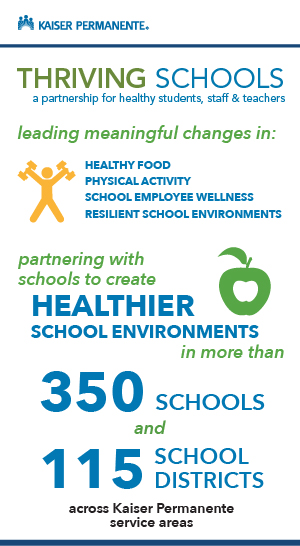 Kaiser Permanente recently released results from 11 studies on community health initiatives that spanned more than 10 years. Two of the studies highlight key successes in improving health outcomes around physical activity and healthy lunches in schools.
Kaiser Permanente recently released results from 11 studies on community health initiatives that spanned more than 10 years. Two of the studies highlight key successes in improving health outcomes around physical activity and healthy lunches in schools.
Over the past decade, Kaiser Permanente used different aspects of its Healthy Eating Active Living (HEAL) initiative to improve health policies, programs and ultimately health outcomes across more than 60 communities, positively impacting the health of more than 715,000 people.
What are the main takeaways from the studies involving schools? Results from the HEAL work are encouraging and can serve as a model for future work.
Changes in school food preparation methods result in healthier cafeteria lunches in elementary schools
This study examined the impacts of changes to districtwide food service and preparation in elementary school lunches.
Simple interventions showed promise for improving elementary cafeteria food offerings, such as school chef trainings and emphasizing serving healthier items such as fruit and veggies instead of breaded and processed foods.
Increase in physical activity sustained a year after playground intervention
In this study, researchers looked at how improvements to playgrounds can lead to an increase in students’ physical activity.
After a playground received a redesign — new swings, a climbing structure, slides, a spinning carousel, and play equipment such as balls and hula hoops — observers recorded an increase in physical activity among the students.
Other research papers cover topics including improving healthy eating and activity in home-based child care settings, increasing food security, and obesity prevention. Find out more in the Kaiser Permanente announcement, or read the peer-reviewed studies published in the American Journal of Preventive Medicine.




